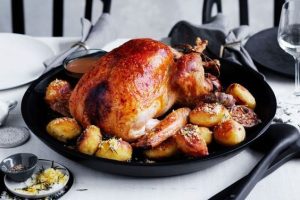Roast vs Bake
The terms “roast” and “bake” are often used in cooking, and while they might seem similar, they are distinct methods of preparing food. Roasting typically involves cooking food, especially meats, uncovered in the oven at higher temperatures, often around 350°F (175°C) or higher. This method is used to brown the exterior of the food, creating a flavorful crust while retaining moisture inside. Roasting is commonly associated with meats, but it can also apply to vegetables.
Baking, on the other hand, involves cooking food, both sweet and savory items, in the oven at lower, more consistent temperatures, usually around 325°F (163°C) or lower. Baking is a gentler cooking method that allows food to cook evenly from the inside out. It’s commonly used for items like bread, cakes, cookies, casseroles, and pies.
Roasting and baking are two cooking methods that are often used interchangeably, but they have distinct differences in terms of technique and the types of dishes they are typically used for:
Temperature and Heat Source:
- Roasting involves cooking food at a higher temperature, typically above 400°F (200°C). It is usually done in an open pan or on a rack, allowing hot air to circulate the food. Roasting is often associated with cooking meats and vegetables.
- Baking: Baking, on the other hand, is done at lower temperatures, usually between 300°F and 375°F (150°C to 190°C). It is primarily used for bread, cakes, pastries, and casseroles. Also, read some different about showbiz Exploring the Glamorous World of Hollywood Actresses
Purpose:
- Roasting: Roasting is commonly used to develop a rich and savory flavor, as it allows the Maillard reaction to occur, creating a browned and caramelized exterior on meats and vegetables. It’s often used for roasting whole chickens, turkeys, or root vegetables.
- Baking: Baking transforms raw ingredients into a finished product with a desired texture. It’s used for items like bread to create a crisp crust and soft interior or for cakes to make them rise and become fluffy.
Cookware:
- Roasting: Roasting is often done in shallow pans or on a roasting rack placed inside a baking sheet to allow air circulation. It can also be done directly on a grill or spit for significant cuts of meat.
- Baking typically involves using specific bakeware like cake pans, muffin tins, and loaf pans. It’s also done in ovens, and the choice of bakeware depends on the specific recipe.
Examples:
- Roasting: Roast chicken, roast beef, roasted vegetables, and roasted potatoes.
- Baking: Baked bread, baked lasagna, baked salmon, and baked desserts like cakes, cookies, and pies.
Understanding the Basics
The Fundamental Difference
- Roasting typically involves cooking meat or vegetables at higher temperatures, usually above 300°F (150°C). It aims to create a crispy, caramelized exterior while preserving moisture inside.
- Baking: Baking, on the other hand, usually involves lower temperatures, typically ranging from 300°F (150°C) or below. It focuses on even, gentle cooking to achieve a soft or firm texture.
Cooking Vessels
- Roasting: Roasting is often performed in uncovered pans or trays, allowing heat to circulate freely and create browning.
- Baking usually occurs in enclosed containers like baking dishes or pans, maintaining a more controlled cooking environment.
When to Roast?
Ideal Ingredients for Roasting
- Meats: Roasting is perfect for meats such as chicken, turkey, beef, and pork. It brings out their rich flavors and creates savory, crispy skin.
- Root Vegetables: Vegetables like potatoes, carrots, and parsnips roast beautifully, developing a delightful caramelized exterior. Also, read about eggs How to Tell if Egg is Bad: A Guide to Freshness

Roasting Techniques
- Dry Heat: Roasting primarily employs dry heat, making it suitable for meats and vegetables that benefit from a crispy, flavorful exterior.
When to Bake?
Best Candidates for Baking
- Bread and Pastries: Baking is essential for achieving light, airy bread and delectable pastries like croissants and cakes.
- Casseroles: Baking is commonly used for dishes like lasagna, macaroni and cheese, and casseroles that require even cooking.
Baking Techniques
- Moist Heat: Baking relies on moist heat, ideal for dishes that need to rise or maintain a soft texture, like bread and cakes.
The Temperature Factor
Roasting Temperatures
- High Heat: Roasting often requires temperatures of 350°F (175°C) and above, creating a searing effect on the exterior.
Baking Temperatures
- Moderate Heat: Baking usually occurs at temperatures ranging from 300°F to 350°F (150°C to 175°C), promoting gentle and even cooking.
Taste and Texture
Flavor Enhancement
- Roasting: Roasting intensifies the natural flavors of meats and vegetables, offering a deep, savory taste.
- Baking: Baking enhances the sweetness of ingredients, making it perfect for desserts and baked goods.
Texture Variation
- Roasting: Roasting yields crispy exteriors and tender interiors.
- Baking: Baking produces a soft or flaky texture, depending on the recipe.

Combining Techniques
Roast-Bake Fusion
Some recipes call for a combination of both methods. For example, roasting and baking a chicken with a sauce can result in a delightful culinary masterpiece.
Conclusion
In the realm of cooking, knowing when to roast and when to bake can elevate your culinary skills. Roasting excels at creating savory, crispy dishes while baking specializes in producing sweet, soft, and fluffy treats. Understanding the nuances between these techniques empowers you to explore a world of gastronomic delights.
FAQs
Can I bake meat instead of roasting it?
While baking meat is possible, roasting is recommended for achieving that desirable crispy exterior and succulent interior.
What’s the key to a perfect roast?
Patience and precise temperature control are essential for a perfect roast. Ensure your meat is well-seasoned and cooked to the desired doneness.
Can I bake bread without an oven?
Baking bread traditionally requires an oven, but some alternatives like a bread machine or stovetop methods can be explored.
Is it possible to roast and bake in a convection oven?
Yes, convection ovens are versatile and can handle both roasting and baking. They offer even cooking with a fan that circulates hot air.
How can I prevent my baked goods from becoming too dry?
To prevent dryness, follow the recipe’s instructions carefully, and avoid overbaking. Properly store baked goods in airtight containers after cooling.
